
Subproject G2: Controls on lithospheric deformation, erosion and plateau formation in the Central Andes inferred from thermomechanical modeling
Research Field: Geodymamics, Structural Geology, Petrology, Geochemistry, Geophysics
-
Research staff
-
Working area
-
Abstract
-
Objectives, methods, work plan, and schedule
-
Collaboration with external research groups
-
Publications
Staff
Project-Leader(s)
Co-Leader(s)
Members
Working area of the subproject G2
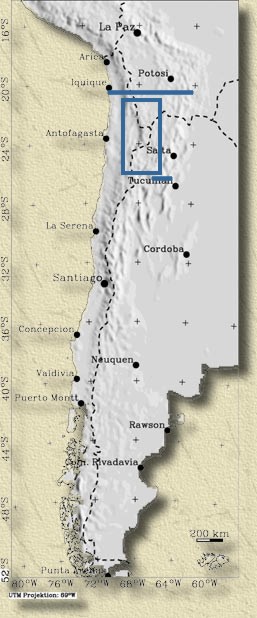
Fig. 1: Working area of project G2
Abstract
We will test three potential determinates of orogen-parallel variations in Neogene shortening and topography of parts of the South American plate involved in Andean subduction and orogenesis: (1) the mechanical interaction of upper (South American) and lower (Nazca) plates, particularly the compositionally dependent rheology and thickness of the former; (2) variable erosion and erosion rates in the Andean plateau and on its flanks; (3) thinning of the upper mantle during lithospheric shortening, especially beneath the Andean plateau. These determinates are not mutually exclusive, but we must test them in separate modeling programs because they involve different processes whose contrasting rheological and petrological boundary conditions necessitate the use of different numerical techniques.
Modeling of (1) and (2) will shed light on why shortening beneath the Andean Plateau decreases from north to south, and why the Miocene-Recent topography and structure of the plateau itself changes so markedly from north (Altiplano) to south (Puna) of 23-24?S. Specifically, we will analyze the effects of varied mechanical coupling between the subducting and overriding plates, of thermal, lithological and rheological heterogeneity in the upper plate, and of varied erosion rates in the upper plate. The discrete elements approach is best suited to examine these effects because it facilitates the simulation of large orogenic displacements while allowing incremental changes in the physical properties (rheology, density) of the lithosphere and the surficial (erosion-dependent) characteristics of the upper plate.
Modeling of (3) will investigate effects of upper mantle thinning on Neogene deformation of the overriding South American plate. Finite Element modeling will allow us to assess the relative significance of potential subcrustal processes on the thermal and structural state of the Andean crust, including mantle delamination, convective erosion of the thermal boundary layer, and slab breakoff. These processes potentially affected the orogenic lithosphere in different ways and influenced the evolution of the plateau. To obtain critical independent constraints on the mantle (composition, p-T conditions and timing of mantle melting), the modeling will be supplemented with a focussed geochemical and geochronologic study of key mafic volcanic centers in the southern Puna plateau.
Objectives, methods, work plan, and schedule
Objectives
We will test three potential determinates of plateau uplift in the Central Andes: (1) Crustal thickening by lateral shortening; (2) low erosional rates within the plateau compared to the plateau margins; and (3) thinning of the lithospheric mantle. The aim is to assess the relative importance of these processes and investigate how their interaction affects deformation patterns and uplift histories in different parts of the orogen. We will do this by performing numerical experiments that incorporate the following main variables:
-
Rheology and strength distribution in the upper (South American) and lower (Nazca) plates
-
Mechanical coupling of the upper and lower plates, as determined by the rheology of the coupling zone
-
Rheology of the asthenospheric mantle
-
Initial (pre-Miocene) thermal state of the South American plate
-
Erosional rates
We emphasize that it is not our goal to simulate the Neogene evolution of the Andes in exact detail. Rather, the intention is to use numerical experiments to study the response of an Andean orogenic system to controlled changes in the crucial parameters above. It is the choice of material properties and boundary conditions which render the model "Andean". The general features of the model may have applications to the evolution of other mountain belts, like the Alps and Himalayas.
The rates of plateau uplift and the style, timing and rate of deformation in the crust of the Central Andes are known sufficiently well (see projects G6 and G7) to set tight boundary conditions and provide checks on the validity of predicted deformational patterns. In contrast, few constraints are available on the timing of mafic volcanism in the southern Puna plateau and on the Neogene upper mantle beneath the southern Puna. These are crucial for modeling the evolution and rheology of the upper mantle in our experiments. An ancillary objective is therefore to obtain this missing information from a study of Neogene basaltic rocks in the Puna plateau (see cooperation with Profs. S. Kay and B. Coira, see section 3.6.1).
Methods
The numerical modeling will employ two techniques: FLAC FE (Fast Lagrangian Analysis of Continua - Finite Element) and DE (Distinct Element) modeling. The two methods will be used in a complementary way to simulate different but overlapping subsystems of the subduction orogen as there is no single method that can handle deformation in all crustal leves and at all conditions.
The FLAC FE technique is best suited for fully coupled thermo-mechanical models at the lithospheric scale. We will therefore use this code to perform lithospheric scale deformation experiments on the South American plate, and in particular, to examine the conditions for and consequences of mantle delamination. In this model we will not include the lower plate but will use kinematic boundary conditions instead. The DE approach, on the other hand, can accommodate unlimited strain along shear zones and can easily simulate sedimentation and erosion. Therefore, we will use the DE method for parameter studies focussing on crustal deformation, surface processes and the mechanical interaction of upper and lower plates along the coupling zone. In these experiments mantle behaviour will be simulated with boundary conditions (Fig. 5).
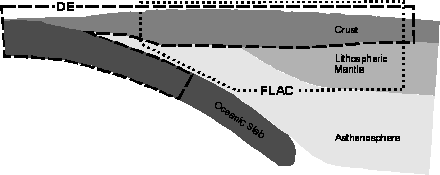
Fig. 2: Extent of model subsystems in G2.
The nature of the two modeling techniques permits a simple comparison of the results and boundary conditions. Both the FLAC FE and DE methods are explicit time-stepping approaches that sequentially calculate forces, displacements and the thermal field. Mechanical and thermal parameters at interfaces common to both subsystems (e.g. the surface of the upper plate, the Moho) can be readily compared and exchanged. In an initial set of experiments we will use the common nature of the techniques to calibrate the thermomechanical properties of the DE aggregates. To this end, we will subject homogeneous blocks of hypothetical rock to numerical deformation experiments with identical boundary conditions using both modeling approaches.
Close communication between project participants will involve frequent exchange of material parameters and boundary conditions between the FE and DE models, and will ensure that -as far as possible- a common set of internally consistent parameters is used for modeling plateau uplift. These boundary conditions include: (1) the heat flow at the Moho; (2) the lithospheric thickness; (3) stresses at the edges of the upper plate; and (4) surface mass transport and load distribution.
1. Numerical experiments with Finite Elements (FLAC FE)
The FLAC FE numerical modeling technique is the modified FE algorithm of Poliakov et al. (1993), which has proven ability for solving problems with strain localization in materials with realistic visco-elastoplastic rheologies. This algorithm will be modified to allow singularities (boundaries with discontinuous displacements, e.g., subduction zones) to be able to model mantle delamination and mechanic interaction of the subducting plate and mantle lithosphere of the upper plate. We will also include in our model metamorphic phase changes in the crust (gabbro-eclogite) and mantle (spinel-garnet) as well as different crustal and mantle rheologies (experimental flow laws for creep of hydrous and anhydrous quartzite, dunite, low-temperature plasticity, etc.). The complexity of coupled thermal and mechanical modeling that incorporates strain localization practically limits the modeling to two dimensions. Although the structure of orogens is obviously three dimensional, simpler two-dimensional models still allow us to explore the key parameters controlling lithospheric deformation and to obtain answers to basic questions about orogenesis.
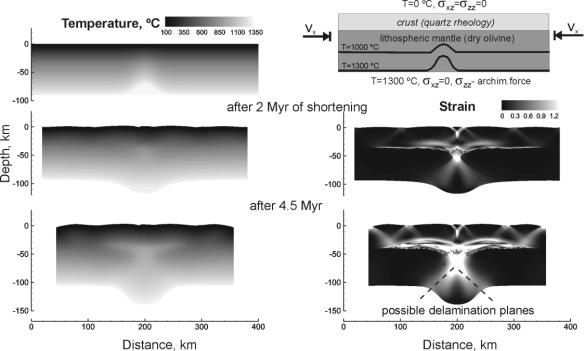
Fig. 3: Thermomechanical FE numerical modeling of shortening lithosphere with an initial thermal anomaly simulating a pre-existing rift. Model geometry and boundary conditions are shown in the upper-righthand corner. For the crust and the lithospheric mantle, we applied visco-elasto-plastic rheologies with a non-linear temperature- and stress-dependent viscosity; dry quartz rheology in the crust and dry olivine in the lithospheric mantle (Ranalli and Murphy, 1987). Assuming that the asthenosphere is relatively weak (e.g. hydrous dunite: Hirth and Kohlstedt, 1998), we model the lithosphere-asthenosphere boundary as a free-slip surface with Archimedian force. The left column shows the initial temperature distribution and its evolution, with snapshots at 2 and 4.5 million years after the onset of shortening. The corresponding finite strain (second invariant of the finite strain tensor) is shown on the right column. In the crust, deformation is strongly localised along faults (brittle crust) and shear zones (viscous crust). In the mantle, all the deformation is localised within the hot anomaly, resulting in root growth. Deformation in the root is strongly heterogeneous, a possible condition for detachment or delamination of the lithospheric mantle.
We have already applied a modified FE code to the problem of deformation and partial melting in the upper plate in the Central Andes (Babeyko et al., 2000b,c,d). In preparation for the proposed project, we ran a number of thermo-mechanical experiments related to lithsopheric mantle delamination. Fig. 2 shows results of one such experiment involving the shortening of a thermally heterogeneous lithosphere such as might have occurred beneath the Late Cretaceous Salta rift (see figure caption for details). From those experiments, we conclude that our code has excellent potential for modeling delamination, but must be modified to allow singular boundaries if other processes such as detachment are to be modeled. As constraints for our numerical modelling we will use geophysical observations, especially specified and reinterpreted seismic tomographic images (group G1) and new seismic images in the Southern Puna (group G3). These images, however, can only provide present-day snapshots of the mantle lithospheric thinning process. Information on the mechanism and timing of this process will be derived from the petrological and geochemical studies of the mantle-derived basaltic melts in the back-arc region of the Southern Puna.
2. Petrology of basaltic melts
Major and trace element data from mafic volcanic centers in the southern Puna plateau will constrain the source and melting conditions of mantle-derived basaltic melts beneath the plateau. It is clear from existing studies (e.g., Kay et al., 1994 and Coira, pers. comm.) that near-primitive MgO-rich basalts exist but that whole-rocks do not preserve the composition of primary magmas because there was considerable crustal contamination of the magmas prior to eruption. We therefore adopt two new approaches to avoid or minimize this problem: (1) We will measure trace element composition of mineral phases -in particular REE and HFSE contents in clinopyroxene- and derive the corresponding composition of the melt phase by inverting these compositional data. Mineral-melt element partitioning data and models for basaltic systems are sufficiently advanced for us to do this with confidence. Measurements will be performed with both a laser-ablation ICP-MS and conventional electron microprobe. Both instruments are available at the GFZ Potsdam. (2) Microbeam techniques (SIMS; EPMA) will allow us to measure directly the composition of melt inclusions trapped in olivine phenocrysts. Preliminary study of samples collected by the current SFB project E2B shows that suitable melt inclusions can be expected.
The element composition of the melt inclusions will yield information on the mineralogy of the mantle source. Trace elements, in particular REE elements, will allow us to distinguish between garnet-bearing and spinel-bearing sources, and thus to constrain the depth of melting. Furthermore, homogenization experiments will establish the minimum temperature of olivine-host crystallization. In addition to trace elements, the SIMS analysis of melt-water content will allow us to ascertain whether melting involved dry or metasomatized mantle. Xenoliths offer the greatest potential for petrologic information about the mantle, and mantle xenoliths have been described but not yet studied from one of the mafic volcanic centers we propose to study.
The timing of lithospheric thinning is critical for our modeling and two sources of age data will potentially provide these constraints: (1) fission-track ages from project G3, and (2) 39Ar-40Ar ages of basaltic magmatism. Some of the mafic volcanic centers in the region have been dated and we will perform additional age determinations on key centers. Selection of key centers for dating and samples suitable for melt inclusion and clinopyroxene microanalysis will be expedited by collaboration with Prof. B. Coira of Jujuy, Argentina and Prof. S. Kay of Cornell Univ., USA.
3. Numerical experiments with Discrete Elements (DE)
The simulation of upper and lower plate interaction must account for some 1500 km of displacement during Neogene formation of the Andean plateau. The modeling approach chosen must therefore be able to accommodate large slip along the plate interface, to simulate long-term strength variations along this interface, and to localise and delocalise strain in shear zones within the upper plate.
We propose exploring the behaviour of the Andean system with the distinct element method (DE, Cundall 1971, 1988, 1992; ITASCA Consulting Group 1999). In this two-dimensional approach, the hypothetical rock comprises variably sized circles that impinge on each other. The mechanical laws governing the interaction of these circles at their mutual point contacts can be varied in order to simulate rock rheologies. The DE method is well suited to study orogenic systems because it incorporates the following features: (1) The ability to accommodate large, localised displacements is inherent to the method because permanent strain occurs by repeated slip along particle contacts. Thus, the model can undergo infinite strains, while rheologies and densities can be modified incrementally during deformation; (2) Modifications of the contact laws between the particles of the model allow the simulation of temperature- and strain rate- dependent rheologies and anisotropies for both the upper plate and the coupling zone between the two plates. These properties of the DE method, especially its ability to simulate unlimited deformation along localised shear zones, set it apart from other methods based on continuum mechanical approaches (e.g., finite element, finite difference). The DE method will enable us to model the Andean orogen as an interactive system comprising three mechanically distinct entities: the subducting Nazca plate, the overriding South American plate and the coupling zone between these plates. In this way, we hope to assess the relative contributions of rheology, inherited structure and thermal state, and kinematic boundary conditions (e.g. convergence rate) on the style and distribution of strain within the Andean orogen. We feel that using the DE method to model large-strain, localised deformation and erosional processes more than offsets any inherent disadvantages associated with two-dimensionality and the calibration of contact laws.
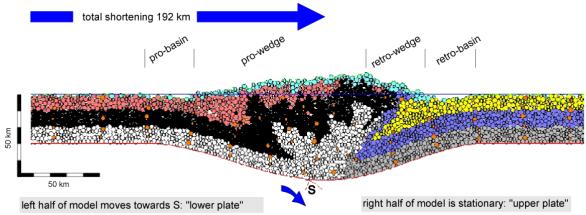
Fig. 4: Numerical simulation of an orogenic collision using distinct elements. Noncohesive Mohr-Coulomb rheology: angle of friction 20?, flexural isostasy: Te=10 km E=70 GPa, surface erosion rate 0.5 % of convergence rate. Initial geometry: crustal thickness 30 km, length of model 600 km.
In an initial phase of the project, we will develop, implement and verify model materials for the DE method. Whereas contact laws for brittle-frictional behaviour are well established with the DE method, viscous contact laws do not yet yield bulk rheologies that approximate the experimentally derived rheologies of polyphase rocks undergoing heterogeneous deformation. To this end, we will design a series of experiments to calibrate viscous contact laws using FLAC FE and an implicit continuum technique (Abaqus). Because the bulk rheology of the model materials cannot be derived analytically from the contact laws, it must be obtained by running numerical simulations of biaxial tests. In effect, we must iteratively change the contact laws in these experiments until we can derive a bulk flow law that approximates natural behaviour. The goal is to derive flow laws that behave identically to the theoretical flow laws derived by Handy (1994) and Handy et al. (1999) for bimineralic aggregates undergoing either frictional-viscous or fully viscous flow.
In a second phase we will use the calibrated model materials to construct a starting model of the pre-Neogene situation in the Central Andes. Using this model we will quantify the relative importance of several parameters in controlling the distribution of deformation in the upper plate (Fig. 5).
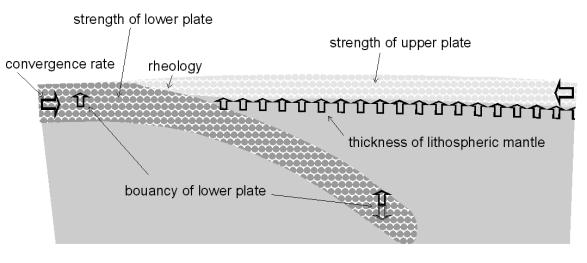
Fig. 5: Initial setup of numerical DE model. Areas filled with circles will be modeled using distinct elements. The subducting Nazca plate will be modeled as an elastic slab with variable strength. Rheology of the South American plate will be defined by existing model materials for which modeled stress-strain relationships are compared with experimentally derived stress-strain curves for rocks. Relative motion of the two plates will be fixed by stress or velocity boundary conditions. Boundary conditions will also simulate mantle behaviour. Labeled parameters will be subject to systematic variation to as a part of the controlled study.
In this relatively simple orogenic system, we will systematically and independently vary several parameters. (1) the strength and buoyancy of the lower plate, (2) the rate of convergence, (3) the rheology and strength (thickness and/or cohesion) of the South American plate, (4) the coupling between the two plates, as expressed by the rheology of the coupling zone, and (5) rheological inhomogenities (soft spots) associated with thermal weakening.
Modeling will include the Neogene evolution of the Central Andes' topography, kinematics and dynamics as well as subsidence rates and positions of foreland basins. Using the particle paths, we will be able to calculate the gravity field of the model. The model output will be compared with available geological and geophysical data to evaluate the general features of our models.
Constraints on the mechanical behaviour of the forearc will be supplied by project F1. Our model will be limited in spatial resolution to element sizes larger than 500 m whereas the spatial resolution of the models proposed by F1 will be in the range of 40 m. The group will investigate in detail the role of forearc rheology and mechanical discontinuities in the forearc for both stress and mass transfer to the backarc. Thus we will extract average values for forearc strength and mass flux from the results of F1.
Work plan and schedule
2002:
FLAC Modeling
Numerical analyses using the existing FE code to examine the effect of shear heating during lithospheric shortening on temperature of the mantle lithosphere and the influence of mantle rheology and shortening rate. Modification of the FE code in order to incorporate boundary elements and phase transformation in the crust and upper mantle. Tests for stability and reliability. Preparation and optimization of a parallelized version of the modified code to allow computation on computers with a large number of processors. Set-up and testing of conceptual models for the numerical experiments. DE Modeling
Development and implementation of time and strain dependent contact laws in simple biaxial numerical tests. Verification of contact laws using FLAC FE models and an implicit method (Abaqus) at small strains.
Development of initial model of the Andean system using frictional contact laws. With this model testing of different erosion algorithms (to be developed together with G6). Implementation of thermal and stress boundary conditions.
Petrology
Sample selection from existing collections (Jujuy, Cornell, Berlin-Potsdam) and a joint field trip with external partners to collect at key localities (xenoliths). Most of the year will be spent with laboratory preparation for melt inclusion and phenocryst phase microanalyss and preparation of samples for age dating.
Data required from other groups of the SFB
none
2003:
FLAC Modeling
Completion of shear heating analysis and preparation of publication. Running numerical experiments which will explore the key factors effecting separation of the mantle lithosphere from the crust: e.g. density of the mantle lithosphere, rheology of mantle lithosphere (including Peierls-mechanism, rheology of the crust, gabbro-eclogite transformation in the crust, thermal structure, shortening rate, erosion by the subducting slab, etc. Identification of the range of parameters which allow mantle separation. Running numerical experiments to explore the effect of mantle lithosphere separation on crustal deformation and deformation of the subducting plate. DE Modeling
Construction of simplified orogenic model described in 3.5.2. Thermomechanical modeling of the simplified system to quantify the relative importance of several parameters in controlling the distribution of deformation in the upper plate (parameters listed in 3.5.2).
Calculation of gravity field of the model (together with F4). Comparison of models? output with available geological and geophysical data to evaluate the general features of our models (see cooperations in section 3.6).
Petrology
Microanalysis (SIMS and ICP-MS) on the melt inclusions and phenocryst phases. First geochemical modeling based on these results and preparation of a publication. Age dating of selected samples and integration of dating results in the project.
Data required from other groups of SFB
Geological information on the pre-Neogene situation (project Z) in order to initiate modeling at the beginning of 2003. Composition, temperature and rheological properties of the present-day Central Andean lithosphere-asthenosphere from preliminary models of group G1. Constraints on boundary conditions like deformation rates (G6, G7), rates of sediment flux (G7, G8) and rheological parameters of both the mantle (F2), the crust (F1, G5) and the coupling zone (F1, F3).
2004:
Petrology
Completion of analytical work. Preparation of publications.
Numerical Modeling (FLAC and DE):
Numerical experiments with the two methods using mutually exchanged boundary conditions (see section 3.5.2) to assess the relative importance of controlling factors for plateau formation. Comparison of modeling results with available geological and geophysical data. Preparation of publications.
Data required from other groups of SFB
Geological data obtained in projects G6, G7, G8 and the distribution of geophysical parameters in the system (F4, G1, G3, G4) for comparison with modeling results.
Collaboration with external research groups
Prof. Suzanne Kay (Cornell Univ., USA) and Prof. Beatriz Coira (Jujuy, Argentina), two authorities on the Neogene Puna volcanism, have agreed to cooperate with us in our focussed study of mantle-derived magmatism from beneath the Puna plateau.. Their expertise and their access to samples from the Puna mafic centers will greatly facilitate this aspect of the project.
For the development of the strain and strain-rate dependent rheologies for the DE method we will continue our cooperation with Peter Cundall (Itasca Inc. USA) and the Itasca Consulting GmbH Germany.
Publications
Posters
The SFB 267 poster index is available on the poster page
Literature
Reviewed publications
Babeyko, A., Sobolev, S., Lavier, L., Trumbull, R. and Oncken, 0. (2000): Thermomechanical modelling of the Altiplano-Puna plateau: multidisciplinary constraints and first results.. - European Geophysical Society 25th General Assembly, : ; Nice. - []
Caffe, P.J., Trumbull, R.B., Coira, B.L. & R.L. Romer (2002): Petrogenesis of early volcanic phases in Northern Puna Cenocoic magmatism. Implications for magma genesis and crustal processes in the Central Andean Plateu. - Journ. Of Petrology, 43: 907-942.
Franz, G., Lucassen, F., Trumbull, R. (1999): The Continental Crust of the Central Andes (21?-26?S) - The petrological - geochemical perspective. - European Union of Geosciences 10, March 28-April 1, Journal of Conference Abstracts, 4 p: 420; Strasbourg. - []
Lindsay, J.M., Schmitt, A. K., Trumbull, R. (2000): Eruption de deux vastes ignimbrites distinctes d'une chambre magmatique stratif?e: Soc. Volcanologique Europ?enne, Gen?ve. - Informations, 3: 7-15; . - []
Lindsay, J.M., Schmitt, A., Trumbull, R. (1999): Contrasting eruption mechanisms of cogenetic, large-volume ignimbrites from the La Pacana Caldera, north Chile. - lUGG 99, Birmingham 26- 30 July, Abstracts vol. B: p. B 170; Birmingham. - []
Lindsay, J.M., Schmitt, A., Trumbull, R. (1999): Contrasting eruption mechanisms of cogenetic, large-volume ignimbrites from the La Pacana Caldera, north Chile. - J. Volcanology and Geothermal Res., 106: 145-173. - []
Lindsay, J.M., Schmitt, A.K., Trumbull, R.B., de Silva, S.L., Siebel, W., Emmermann, R. (2001): Magmatic evolution of the La Pacana Caldera system, Central Andes, Chile: compositional variation of two cogenetic,large-volume felsic ignimbrites and implications for contrasting eruption mechanisms.. - Journal of Petrology, 42: 459-486; . - []
Schmitt, A. K. (2001): Gas-saturated crystallization and degassing in large volume, crystal - rich dacitic magmas from the Altiplano - Puna, northern Chile. - Journal of Geophysical Research, 106, No B12, 30: 561-578.
Schmitt, A. K., Composition of melt inclusions in crystal-rich dacites: Evidence for gas-saturated large-volume magma systems. - Submitted to Journal of Geophysical Research, : ; . - []
Schmitt, A. K., Kasemann, S., Meixner, A. & Rhede, D. (2001): Boron in Central Andean Ignimbrites: Implications for Crustal Boron Cycles in an Active Continental Margin. - Chemical Geology, 183: 335 - 349.
Schmitt, A. K., Lindsay J.M., de Silva, S., Trumbull, R. Ion microprobe U-Pb zircon chronostratigraphy of late-Tertiary ignimbrites.. - Geoth. Res., in press.
Schmitt, A.K., and de Silva, S.L. (2000): The Merzbacher & Eggler (1984) Geohygrometer: a Cautionary Note on its Suitability for High-K Suites. - J. Petrol., 41: 357- 362; . - []
Schmitt, A.K., de Silva, S.L., Trumbull, R.B., Emmermann, R. Conditions of upper crustal magma storage of the Purico Complex, N. Chile and consequences of recharge for igmimbrite-forming magmas. - Contrib. Mineral. Petrol., : ; . - []
Schmitt, A.K., Kasemann, S., Meixner, A., Rhede, D. Boron isotopic composition of Central Andean ignimbrites: implications for crustal boron cycles in an active continental margin. - Chemical Geology, 183: 335-349; . - []
Schmitt, A.K., Lindsay, J.M., deSilva, S., Trumbull, R.B. Ion microprobe U-Pb zircon chronostratigraphy of late-Miocene ignrimbrites from La Pacana, North Chile: implications for the formation ofstratified magma chambers.. - J. Volc. and Geoth. Res., : ; . - []
Schmitt, A.K., Trumbull, R.B., Ernmermann, R. (1999): Conditions of upper crustal storage and eruption of felsic magmas - insights from a melt inclusion study of the Purico complex, N. Chile, European Current Research on Fluid Inclusions ECROFI XV, June 21-24, 1999. - Terra Nostra, 99/6: 261-262; . - []
Springer, M. (1999): Interpretation of heat-flow density in the Central Andes. - Tectonophysics, 306: 377-395; .
Trumbull, R., Lindsay, L, Schmitt, A., Siebel, W., Schilling, F., Giese, P., Wigger, P., Brasse, H., Lucassen, F., Franz, G. (1999): Crust - mantle mixing in continental arc magmas: Petrologic and petrophysical investigations in the Central Andes. - European Geophysical Society 24 General Assembly, Geophysical Research, Abstracts, v. 1 Nr. 1: p. 66; The Hague. - []
Publikationen in Tagungsbänden
Laube, N., Springer, J., and Trumbull, R.B. (1997): A 4-stage model for the ignimbrite volcanism in the Altiplano-Puna Volcanic Complex (APVC). Numerical investigation of crustal melt ge ignimbrite volcanism in the Altiplano-Puna Volcanic Complex (APVC). Numerical investigation of crustal melt generation. - Proceedings of the Third Annual conference for Mathematical Geology, IAMG, Barcelona, 1997 Annual Conference for Mathematical Geology, IAMG, Barcelona, 1997: 385-388; .
Lindsay, J.M., de Silva, S., Trumbull, R.B. (1998): Complex magmatic relations in the La Pacana caldera system, Andean Central Volcanic Zone, North Chile. Geo-Berlin 1998, 6.-9. Oct.. - Terra Nostra, 98/3: V209-V210; .
Schmitt, A. K., Hervig, R., de Silva, S., Trumbull, R. (1998): Thermal and compositional variation in a felsic magma chamber: a melt inclusion study of the Purico Complex, N.-Chile.. - IAVCEI Int. Volc. Congr., Cape Town, SA, July 11-16, Abstracts: 53.
Schmitt, A., Lindsay, J., Thomas, R., Trumbull, R., Siebel, W. (1997): Estimates of magmatic pressure, temperature and water concentrations in late Neogene ignimbrites of the Altiplano-Puna Volcanic Complex: evidence for deep-seated magma chambers.. - Deformation Processes in the Andes - new Data , Antofagasta, Chile and Problems, Workshop, July 31 - August 2, 1997, : ; Antofagasta/Chile.
Schmitt, A.K., Hervig, R., de Silva, S., Trumbull, R.B. (1998): Magmatic evolution of monotonous felsic ignimbrites: the Purico Complex, N.- Chile. 16. Geowissenschaftliches Lateinamerika-Kolloquium, Bayreuth, 14. -16. Oct.. - Terra Nostra, 98/5: 146; .
Schmitt, A.K., Trumbull, R.B., Lindsay, J.M., R. Emmermann (1999): Assessment of the depth of intracrustal melt generation and magma storage zones in the Central Andes - insights from ignimbrite petrology and geochemistry. - 4. International Symposium on Andean Geodynamics, Oct. 4-6, 1999: p.659-662; G?ttingen. - []
Siebel, W., Trumbull, R.B., Lucassen, F., Emmermann, R., Haase, G., Hahne, K., Kraemer, B., Lindsay, J.M., Schmitt, A., Schnurr, W., Wolter, M. (1998): Isotopic contrasts in Neogene ignimbrites from the central Andes (23?S - 27?S): source heterogenity or different petrogene 27?S): source heterogeneity or different petrogenesis? 16. Geowissenschaftliches Lateinamerika-Kolloquium, Bayreuth, 14. -16. Oct.. - Terra Nostra; 16. Geowissenschaftliches Lateinamerika-Kolloquium, Bayreuth, 14.-16. Okt., 98/5: 152; .
Siebel, W.,.Schnurr, W., Hahne, K., Kraemer, B Trumbull, R.B. (1999): Neogene silicic magmatism in the southern central Andes (25-27?S, 67-69?W): new aspects of ignimbrite formation. 4. Int. Symp. on Andean Geodynamics, G?ttingen, Oct. 4-6, 1999. - Institut de Recherche pour le Developpement, : 686-688; Paris.
Trumbull, R., Lindsay, J., Schmitt, A., Siebel, W., Schilling, F., Giese, P., Wigger, P., Brasse, H., Lucassen, F., Franz, G. (1999): Crust - mantle mixing in continental arc magmas: Petrologic and petrophysical investigations in the Central Andes. European Geophysical Society 24th General Assembly, The Hague, 19-23 April 1999. - Geophysical Research Abstracts, 1: 66; .
Qualifikationsarbeiten (Habilitationsschriften, Promotionen, Diplomarbeiten) und interne Berichte
Lindsay, J.M. (1999): Stratigraphy, age relations and magmatic evolution of large-volume, felsic ignimbrites of the La Pacana Caldera, Central Andes, Chile large-volume, felsic ignimbrites of the La Pacana Caldera, Central Andes, Chile. - Scient. Techn. Report GFZ Potsdam, STR 99/16: 141 pp.; Potsdam.






